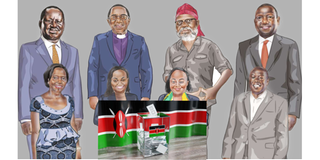What Kenyans will be voting for tomorrow

Tomorrow Kenyans will choose who, between Mr Raila Odinga of Azimio la Umoja One Kenya and Kenya Kwanza’s Deputy President William Ruto,Mr George Wajackoya of Roots Party and Agano Party’s David Mwaure to succeed President Uhuru Kenyatta
Tomorrow Kenyans will choose who, between Mr Raila Odinga of Azimio la Umoja One Kenya and Kenya Kwanza’s Deputy President William Ruto, will succeed President Uhuru Kenyatta.
Other than the two leading candidates, there is also Mr George Wajackoya of Roots Party and Agano Party’s David Mwaure.
Mr Odinga and Dr Ruto have made myriad promises, which Kenyans will be voting for or against at the ballot.
The promises, which are largely similar and heavily borrow from previous election pledges, are contained in their manifestos.
Azimio’s manifesto, anchored on a social protection plan that includes giving Sh6,000 per month to each of the two million most needy and vulnerable households, is summarised in a 10-point agenda “to transform the country”.
The 10 points are: Azimio la Ugatuzi, Azimio la Jitihada, Azimio la Kina Mama, Azimio la Ukulima, Azimio la Viwanda, Azimio la Wananchi, Azimio la Uwajibikaji, Waste Not a Single Child, Maji kwa Kila Boma and BabaCare.
On the other hand, Kenya Kwanza has the “bottom up” economic model, which seeks to increase employment creation, equitable distribution of income and economic stability, among others.
Kenya Kwanza has identified agriculture, transforming the micro, small and medium enterprises (MSMEs), housing and settlement, healthcare, digital and creative economy, infrastructure, manufacturing, social protection and governance as its agenda for the country.
On the other hand, Mr Odinga has promised to ensure the success of BabaCare, which primarily focuses on social protection and up-scaling Universal Health Coverage. Under this plan, he says, all citizens will enjoy the right to accessible, quality and affordable healthcare in an Azimio administration.
In terms of social protection and transformation, Azimio notes that a nation’s greatness is judged by how it treats its most vulnerable in society.
Inua Jamii, a social protection programme, will deliver the Sh6,000 per month to the needy and vulnerable households. This is expected to trigger economic activity and “create thousands of localised small-scale businesses and enterprises across the country”.
“This will lead to creation of millions of jobs and the eventual development of a thriving middle class,” the Azimio manifesto states.
Kenya Kwanza seeks to achieve 100 per cent National Health Insurance Fund coverage for senior citizens within three years of assuming power, and revamp the cash transfer programme for elderly and vulnerable households by improving operational efficiency, prompt payment, accountability and wider coverage.
DP Ruto has also promised to invest in education and training for caregivers and medical staff to fill the skills gap in the provision of specialised care for older people.
On devolution, Azimio la Ugatuzi will seek to increase devolved resources and advance a “One County, One Product” strategy. This is premised on manufacturing and value addition as the engine for wealth creation and employment to achieve double digit economic growth.
Mr Odinga has also undertaken to support the growth of MSMEs, including the Jua Kali sector through improved productivity and efficiency.
“Kazi kwa Wote will secure the welfare of the people through decent and dignified jobs that uplift their standards of living,” states the Azimio manifesto.
For Kenya Kwanza, MSMEs contribute 85 per cent of non-farm jobs. This, according to the Kenya Kwanza manifesto, will generate at least Sh6 trillion a year, “which is 60 per cent of the GDP”.
To achieve this, Kenya Kwanza has promised to allocate the sector Sh250 billion.
While Mr Odinga has promised a progressive approach to achieve gender parity in appointments, “and at the very least adhering to the two-third gender rule” in elective and appointive public bodies, DP Ruto has promised to ensure that the two-thirds gender rule is actualised within 12 months if he forms the government.
Mr Odinga has also promised to appoint women to improve access to government guaranteed funds and affordable credit to women.
“We intend to enforce the not more than two-third gender rule in elective or appointive bodies as provided for in the constitution with a view to achieving gender parity,” the Azimio manifesto states without providing a time frame.
DP Ruto is also promising to provide financial and capacity building support through the “Hustler fund” for women-led co-operative societies, chamas, merry-go-round and table banking initiatives and protect them from predatory interest rates charged by “unscrupulous money lenders”.
In agriculture, Azimio seeks to ensure the country produces enough to feed its people through the clarion call: Fukuza Njaa. It promises to do this largely by reducing the cost of production and incentivising farmers through providing markets for the farm produce.
Among others, Azimio promises to reduce the cost of fertiliser from the current Sh7,000 for a 50kg bag to about Sh2,000.
It also makes a commitment to create an enabling environment for climate-smart agriculture, agro-processing, improved livestock farming and growth of the blue economy.
“We will commercialise large-scale arable but idle government land into productive agricultural enterprises,” states the Mr Odinga-led coalition’s manifesto.
On the other hand, Kenya Kwanza promises to invest Sh250 billion in agriculture to turn around the sector and reduce the cost of living.
“The cost of living that we are experiencing can only be resolved by raising agricultural productivity. The battle is between farmers needing higher incomes and consumers who want low prices,” the Kenya Kwanza document states.
Manufacturing is at the heart of the country’s economic revolution, and it is a key pillar in Azimio’s agenda.
The Azimio manifesto notes that manufacturing, complemented by agriculture, livestock, the blue economy, and ICT are the key drivers for the “envisaged economic revolution and the apparatus for development” to jump-start and turnaround the economy.
Kenya Kwanza’s manifesto notes that the country’s manufacturing sector is headed in the wrong direction as it has declined from 9.3 per cent contribution to the economy to 7.6 per cent between 2016 and 2020.
“At a time when we should be industrialising, the manufacturing share of the economy is declining. Kenya Kwanza is committed to help our manufacturers weather this storm. Our economic turn-around strategy outlined in this manifesto is meant to put them behind us as quickly as possible,” the document states.
For education, Azimio is promising to ensure that all unemployed trained teachers are employed to improve the quality of education. They also say they will improve the working conditions, welfare and training of teachers.
Their Kenya Kwanza counterparts promise to establish a one year paid internship programme for all students graduating from teachers, technical and medical colleges and universities by collaborating with industry players.





